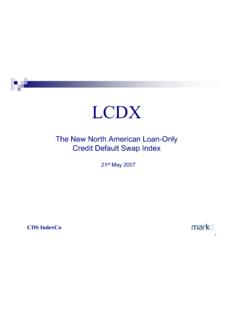Transcription of Credit Indices Primer - Markit
1 1 of 31 Confidential. Copyright 2008, Markit Group Limited. All rights reserved. Markit Credit Indices A Primer November 2008 Markit Credit Indices Primer 2 of 31 Copyright 2008, Markit Group Limited. All rights reserved. Copyright 2008 Markit Group Limited Any reproduction, in full or in part, in any media without the prior written permission of Markit Group Limited will subject the unauthorized party to civil and criminal penalties. Trademarks Mark-it , Markit , Markit CDX , Markit LCDX , Markit ABX, Markit CMBX, Markit MCDX, Markit Loans , Markit RED , Markit Connex , Markit Metrics iTraxx , LevX and iBoxx are trademarks of Markit Group Limited. Other brands or product names are trademarks or registered trademarks of their respective holders and should be treated as such. Limited Warranty and Disclaimer Markit specifically disclaims any implied warranty or merchantability or fitness for a particular purpose.
2 Markit does not warrant that the use of this publication shall be uninterrupted or error free. In no event shall Markit be liable for any damages, including without limitation, direct damages, punitive or exemplary damages, damages arising from loss of data, cost of cover, or other special, incidental, consequential or indirect damages of any description arising out of the use or inability to use the Markit system or accompanying documentation, however caused, and on any theory of liability. This guide may be updated or amended from time to time and at any time by Markit in its sole and absolute discretion and without notice thereof. Markit is not responsible for informing any client of, or providing any client with, any such update or amendment. Markit Credit Indices Primer 3 of 31 Copyright 2008, Markit Group Limited. All rights reserved. Scope of the document This document aims to outline the different Credit Indices owned and managed by Markit , their characteristics and differences, and how they trade.
3 We focus on synthetic Indices backed by single name bonds CDS (senior unsecured) and single name loans CDS (senior secured): the Markit CDX and Markit iTraxx for bonds, and the Markit iTraxx LevX and Markit LCDX for loans. We purposely do not cover synthetic structured Indices , such as the ABX and the CMBX, as their functioning is quite different. Table of Contents Section 1 Credit Default Swaps Definition 4 Types 5 Uses 5 Pricing 6 Notional 6 Section 2 Credit Indices A Brief History 7 Benefits 7 Participants 7 Key Characteristics 7-9 Rules 9-10 Section 3 Trading Credit Indices Trading Overview 11 Valuation 12 Credit Events 12-13 Section 4 Tranches 14 Conclusion 15 Appendices Appendix 1 Roadmap to Credit Indices 16-18 Appendix 2 Index Roll Timeline 19-24 Appendix 3 Roadmap to Tranches 25 Appendix 4 Credit Derivatives
4 Glossary 25-31 Markit Credit Indices Primer 4 of 31 Copyright 2008, Markit Group Limited. All rights reserved. Section 1 Credit Default Swaps Definition A Credit Default Swap (CDS) is a contract between two parties, a protection buyer who makes fixed periodic payments, and a protection seller, who collects the premium in exchange for making the protection buyer whole in case of default. In general trades are between institutional investors and dealers. CDS are over-the-counter (OTC) transactions. They are similar to buying/selling insurance contracts on a corporation or sovereign entity s debt, without being regulated by insurance regulators (unlike insurance, it is not necessary to own the underlying debt to buy protection using CDS). Before trading, institutional investors and dealers enter into an ISDA Master Agreement, setting up the legal framework for trading. Each contract is defined by A Reference Entity (the underlying entity on which one is buying/selling protection on); A Reference Obligation (the bond or loan that is being insured - although it doesn t have to be the deliverable instrument in a default situation and doesn t have to have the same maturity as the CDS, it designates the lowest seniority of bonds that can be delivered in case of default); A Term/Tenor (5 years are the most liquid contracts); A Notional Principal; Credit Events (the specific events triggering the protection seller to pay the protection buyer The defined events are bankruptcy, failure to pay, debt restructuring, and the rare obligation default, obligation acceleration, and repudiation/moratorium).
5 Markit Reference Entity Database (RED) is the market standard that confirms the legal relationship between reference entities that trade in the Credit default swap market and their associated reference obligations, known as pairs . Each entity is identified with a unique 6-digit alphanumeric code, and a 9-digit code identifies the pair. RED codes are widely and successfully used by CDS market participants to electronically match and confirm CDS transactions. The RED preferred reference obligation is the default reference obligation for CDS trades based on liquidity criteria. In case of a Credit event, under standard physical settlement the protection buyer has to deliver a bond of seniority at least equal to that of the reference obligation if there are multiple bonds deliverable, the protection buyer will most likely deliver the cheapest bond to the protection seller. We can represent the life of a CDS with the following cash flows: From initiation of trade to maturity if there is no Credit event: Default Protection Buyer Default Protection Seller Fixed Quarterly Cash Payments (basis points per annum) Markit Credit Indices Primer 5 of 31 Copyright 2008, Markit Group Limited.
6 All rights reserved. In case of Credit Event Note that a market-wide cash settlement mechanism has been implemented in recent years. More details will be covered under Auctions later. Types The different types of CDS contracts traded: CDS: indicates that the underlying reference entities and obligations are senior unsecured bonds, issued by corporate or sovereign issuers LCDS: Loan-only CDS refers to contracts where protection is bought and sold on syndicated secured leveraged loans. These are higher in the capital structure (and with higher recovery rates) than CDS. MCDS: The reference entity is a municipality, and the reference obligation a municipal bond. ABCDS: CDS on structured securities (Asset Backed Securities typically) Preferred CDS: CDS on Preferreds Uses Hedging CDS allow capital or Credit exposure constrained businesses (banks for example) to free up capacity to facilitate doing more business. CDS can be short Credit positioning vehicle.
7 It is easier to buy Credit protection than short bonds. For LCDS, counterparties can assign Credit risk of bank loans without requiring consent of lender (assigning bank loans often requires borrower consent/notification), therefore CDS reduce bank exposure to Credit risk without disturbing client relationships. CDS may allow users to avoid triggering tax/accounting implications that arise from sale of assets Investing Investors take a view on deterioration or improvement of Credit quality of a reference Credit CDS offer the opportunity to take a view purely on Credit CDS offer access to hard to find Credit (limited supply of bonds, small syndicate) CDS allows investors to invest in foreign credits without bearing unwanted currency risk Investors can tailor their Credit exposure to maturity requirements, as well as desired seniority in capital structure CDS require no cash outlay and therefore creates leverage Default Protection Buyer Default Protection Seller Reference Obligation at x% of par + Accrued CDS Interest100% of par of the underlying Reference Obligation Markit Credit Indices Primer 6 of 31 Copyright 2008, Markit Group Limited.
8 All rights reserved. The standardized documentation, liquidity, ability to customize terms, and pure Credit focus has made the CDS market a de facto standard for expressing a view on the Credit market (either single credits, or baskets such as Indices ). Pricing CDS contracts in general trade based on a spread, which represents the cost a protection buyer has to pay the protection seller (the premium paid for protection). The protection buyer is said to be short the Credit as the value of the contract rises the more the Credit deteriorates. The value of the CDS contract increases for the protection buyer if the spread increases. For example, a protection buyer paying a spread of 60bps when the current spread is 90bps would be able to unwind the position at a higher spread level. Estimated recovery is a key part of valuing a CDS contract, as it represents the value post-default, and therefore impacts expected cash flows.
9 For investment grade names, recovery is generally assumed to be 40% (as the probability of default is low, the recovery rate is at best an estimate). For distressed names however, where the probability of default is higher, recovery tends to be more precisely defined. Markit offers comprehensive data service including daily Credit curves for over 3,500 entity-tiers including recovery rates, and valuation services to value trades. Notional It is important here to note that CDS trades refer to a notional, the quantity of the underlying asset or benchmark to which the derivative contract applies. It doesn t refer to any cash exchange at time of trade, the mark-to-market size of the market. It is akin to the amount of insurance bought, not the premium paid. Markit Credit Indices Primer 7 of 31 Copyright 2008, Markit Group Limited. All rights reserved. Section 2 - Credit Indices A Brief History Synthetic Credit Indices originated in 2001 when JPMorgan launched the JECI and Hydi Indices , and Morgan Stanley launched Synthetic TRACERS.
10 Both firms merged their Indices under the Trac-x name in 2003. During the same period iBoxx launched Credit derivatives Indices . In 2004 Trac-x and iBoxx merged to form the CDX in North America and the iTraxx in Europe and Asia. After being the administrator for the CDX and calculation agent for iTraxx, Markit acquired both families of Indices in November 2007, and owns the iTraxx, CDX, LevX, and LCDX Indices for derivatives, and the iBoxx Indices for cash bonds. Benefits Credit Indices have expanded dramatically in recent years, with volumes rising, trading costs decreasing, and a growing visibility across financial markets. Benefits of using CDS Indices include: Tradability: Credit Indices can be traded and priced more easily than a basket of cash bond Indices or single name CDS Liquidity: Significant liquidity is available in Indices and has also driven more liquidity in the single name market Operational Efficiency: Standardized terms, legal documentation, electronic straight-through processing Transaction Costs: Cost efficient means to trade portions of the market Industry Support: Credit Indices are supported by all major dealer banks, buy-side investment firms, and third parties (for example, Markit offers transaction processing and valuations services) Transparency: Rules, constituents, fixed coupon, daily prices are all available publicly Participants There are five main parties involved in Credit Indices : Markit Markit owns and operates the Indices : including licensing, marketing, administration, and calculation.








